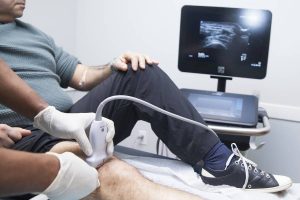Ultrasound-Guided Viscosupplementation/Hyaluronic Acid Injections (Hyalgan/Euflexxa)
Proudly serving Tarzana, Agoura Hills and Los Angeles County
 Viscosupplementation, also known as hyaluronic acid, is a medical procedure during which a gel-like lubricating fluid is injected into a joint under ultrasound guidance. There are many forms of hyaluronic acid, all of which have slightly different properties; the two brands used at PCSM are Hyalgan and Euflexxa. The main difference between the two is that Hyalgan contains egg products, whereas Euflexxa does not.
Viscosupplementation, also known as hyaluronic acid, is a medical procedure during which a gel-like lubricating fluid is injected into a joint under ultrasound guidance. There are many forms of hyaluronic acid, all of which have slightly different properties; the two brands used at PCSM are Hyalgan and Euflexxa. The main difference between the two is that Hyalgan contains egg products, whereas Euflexxa does not.
Hyaluronic acid occurs naturally in joint fluid, acting as a shock absorber and lubricant. However, the acid appears to break down in people with arthritis. Adding hyaluronic acid to the arthritic joint will facilitate movement, reduce pain, and keep the arthritis at bay. Ideally, this procedure should be performed every 6-12 months to prevent the progression of arthritis.
For more information on Hyalgan, please visit www.Hyalgan.com
For more information on Euflexxa, please visit www.Euflexxa.com
What to expect when preparing for your viscosupplementation joint injection (Hyalgan, Euflexxa, Orthovisc)
Viscosupplementation is typically a series of three injections performed weekly. It is okay to wait longer than 1 week between injections but the injection will not be administered less than 7 days from the previous one
- After the injection:
- For lower extremity injections, high impact activities (running, jumping, spinning, etc) are NOT recommended for the first 48 hours
- For upper extremity injections, heavy lifting and excessive upper extremity activities are NOT recommended for the first 48 hours
- After that time, gradual return to full activities is encouraged. Jumping back into all activities full-force is not recommended.
- If performing physical therapy, it can be started/resumed at least 48 hours after the injection
- Risks of the injection
- Risk of infection is present any time the skin is broken but is a low risk. Signs of infection include chills, fever, pain, warmth and redness around the injection site. If you have any of these symptoms after your injection, please call the office.
- Risk of reaction to a component of the medication, which may temporarily cause increased pain, swelling of the joint, and/or limping
- There is a risk that the injection will not work in relieving your symptoms. For this reason, injections are not typically the first line of treatment
- Risk of skin blanching (turning white), skin dimpling, and fat necrosis/skin atrophy at the injection site. These risks are uncommon but can occur and may take up to one or more years to resolve. Rarely, they can be permanent.







